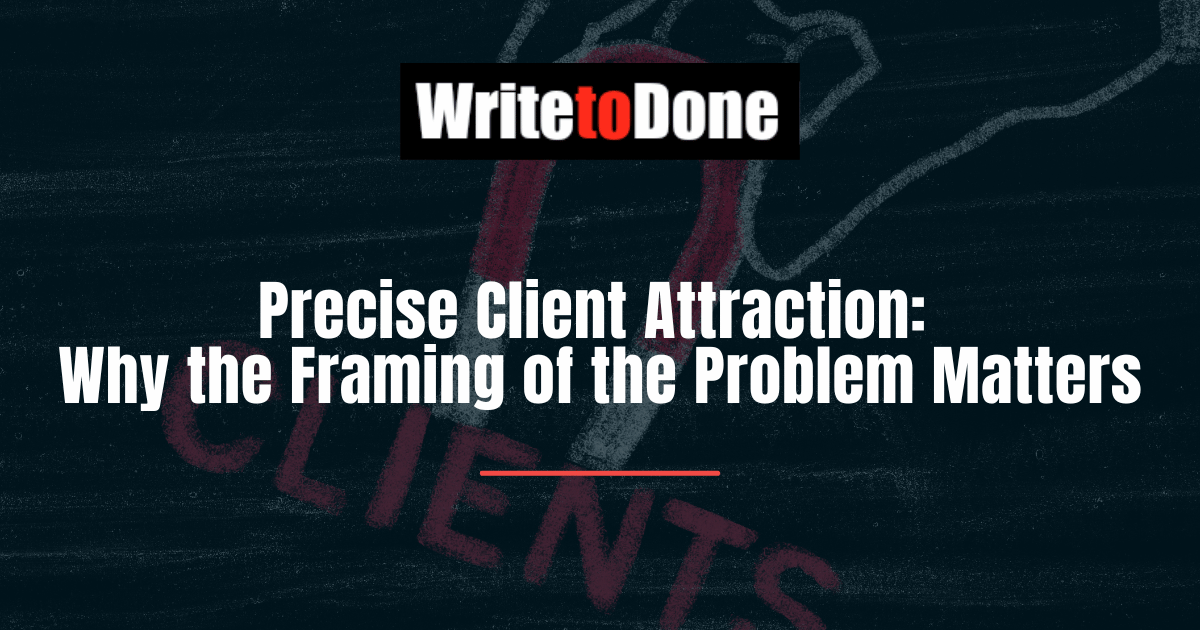I was at the doctor’s clinic one day for a routine check.
“You have to lose about 10 pounds,” he said. “Not that you have any health problem, but you’re kinda on the borderline. And if you lose weight and eat well, you won’t have to take medication for a long, long time.”
Do you recognise the problem in the doctor’s statement?
He didn’t say, ‘lose weight so you can impress everyone on the beach.’ Neither did he say ‘lose weight so you can run the marathon.’ He was specific. Stay away from the borderline and you can avoid having the bother of having to pop endless number of pills.
Most marketing messages aren’t this specific
And the reason why they’re not crystal clear is because the person giving out the message isn’t quite sure how to get the message across. So they put out a message, which soon looks like every other weight loss message. And it doing so, they miss out on the customers they most need to attract and work with.
So let’s take an example here
Christy wants to work with overweight women. But what’s the problem that Christy’s solving? She’s working with women who feel like they’re invisible. These women have put on some weight over the years, and now feel miserable. But more so, they feel invisible. No one seems to notice them as they walk down the street.
As Christy so eloquently puts it, “Women who are significantly overweight feel like social outcasts and are often treated by others as if they are stupid (or have below average intelligence). As a result of being overweight, they feel other people judge them and do not see them for who they really are. They are ignored.
They have to work harder to prove their abilities and overcome the prejudices of being overweight. They find that strangers will often pass right in front of them and not even make eye contact with them. They feel very alone. They are invisible.”
That’s kinda different from what the doc told me, eh?
And we can feel the difference, even though the eventual goal seems to be the same: lose weight. But it’s the framing of the problem that creates enormous intensity. Get the right problem and you’ve hit a home run. Get the wrong problem and you’re just another me-too product.
So how do you go about getting to the right problem?
We need three steps and let’s take this specific example of losing weight.
Step 1: Make a list of reasons why someone would want to lose weight.
Step 2: Pick the top three reasons.
Step 3: Pick one.
Step 1: The list of reasons.
List every single reason why someone would want to lose weight (or in your case, buy your product or service). But let’s stay with the example and let’s say these are the reasons below.
– to feel attractive/special to another
– to feel happier
– to feel in control
– to gain confidence
– to be more popular
– to love self more
– to feel more self-worth
– to avoid needing medication
– to avoid exacerbating a poor health condition
– to gain more self-worth
– to be able to perform activities they are no longer able to
– to feel more important
– to be treated better
– to avoid pain/inconvenience
– to avoid feeling bad anymore about self
– to avoid disappointed feelings that one can’t look how they want to look
– to avoid feelings of disappointment
– to feel loved
Notice how not many of the reasons overlap that much?
Being ‘popular’ isn’t quite the same as ‘being attractive to another person’. ‘Avoid needing medication’ isn’t quite the same as ‘losing your kidney function’. And to belabour the point, ‘being treated better’ isn’t at all the same as ‘gaining more self-worth’.
Every reason is different. And now that you’ve listed all the reasons, you can start cherry picking the ones that most appeal to you or your target profile.*
Step 2: Pick three from the list
So how do you pick three? You guess, I suppose. Or you could be more precise and actually speak to a customer and find out which one appeals to them the most—and why. And no matter how you come to the conclusion, you get three from the list.
And your list starts to look like this:
– to feel loved
– to avoid pain/inconvenience
– to avoid feelings of disappointment
Ah, now we have three, let’s move to the final step.
Step 3: Pick one.
Again you can hopelessly guess you’re right, or you can use your customer’s opinion. But no matter how you go about it, you now have one.
– to avoid feelings of disappointment
Notice how different that choice is from Christy’s choice?
Or from what the doc told me? ‘Avoiding feelings of disappointment’ cascades into ‘why the #%$%4% can’t I lose weight no matter how much I try? What’s wrong with me? Why can’t I just stick to one diet program and finally get over this problem once and for all? Why do some others succeed and I keep failing? Why do I get into this stuff and then fall flat on my face again? And surely, surely there must be a way so I don’t start, only to fail again.
Yes, we’re selling a weight-loss product or service
But unlike what they told you, a rose is not a rose, is not a rose. And neither is a weight-loss product. Even though the end result may appear to be the same for the oblivious onlooker, the result is completely different for the client. One client sees the benefit of never having to go near medication. Another starts to get the odd wolf-whistle. And a third feels that sense of disappointment slither away forever.
So there you have it
It’s a simple formula to send out a precise message and get a precise response from the customer. Frame the problem correctly and the customers flock to you. Frame it wrongly and be banished to me-too land forever.
















